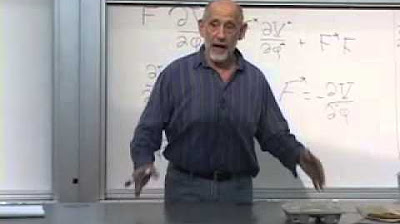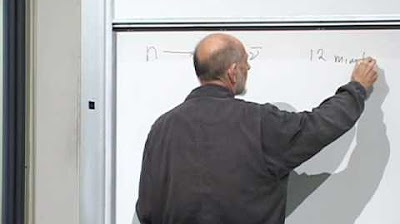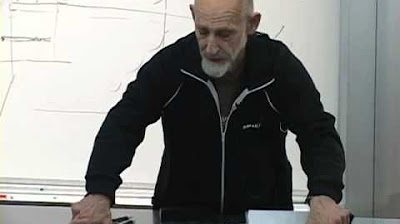8 Standard Model and Beyond, Supersymmetry, and String Theory v2
TLDRIn this eighth installment of the physics textbook series, the speaker discusses advanced topics such as the Standard Model, supersymmetry, and string theory. Despite skepticism about dedicating time to unconfirmed theories, the speaker recommends several influential books that sparked their interest in theoretical physics, including 'Gauge Theories of the Strong, Weak, and Electromagnetic Interactions' and 'Journeys Beyond the Standard Model.' The video also touches on lattice gauge theory, Grand Unified Theories, and provides a historical perspective on string theory, suggesting books for beginners and advanced learners alike.
Takeaways
- 📚 The speaker is discussing physics textbooks, specifically in the context of the standard model, supersymmetry, and string theory.
- 🧐 There is a personal skepticism towards dedicating extensive time to studying theories without experimental confirmation, such as supersymmetry and string theory.
- 🕵️♂️ The speaker's interest in theoretical physics was reignited by the book 'Gauge Theories of the Strong, Weak, and Electromagnetic Interactions', which was republished in 2013.
- 📘 A recommendation is made for books on lattice gauge theory, highlighting its importance and evolution with the advent of super-fast computers.
- 🔬 The speaker suggests that despite grand unified theories being currently unconfirmed, they are likely to be discovered in the future, making related books valuable for understanding.
- 📚 'Journeys Beyond the Standard Model' by Pierre Ramone is recommended for an advanced discussion on the standard model and potential extensions like neutrino masses and supersymmetry.
- 🤔 The speaker admits to not fully understanding all aspects of supersymmetry but recommends a specific book for those interested in learning the subject.
- 🎓 For those starting in string theory, 'The First Course in String Theory' by Barton Zwiebach is recommended, along with an accompanying MIT OCW course.
- 📚 The canonical text for super string theory is by Green, Schwarz, and Whitton, though it doesn't cover all recent developments in the field.
- 📘 Joseph Polchinski's two-volume work is considered the definitive guide for those aspiring to become string theorists, despite its difficulty.
- 🌌 Leonard Susskind's book, while brief, covers a wide range of advanced topics in physics and is recommended for gaining insights into cutting-edge research.
Q & A
What is the main topic of the video?
-The main topic of the video is an overview of the standard model of particle physics, supersymmetry, and string theory, with a focus on the presenter's personal journey and recommended textbooks in these areas.
What is the presenter's view on supersymmetry and string theory?
-The presenter is skeptical about supersymmetry and string theory, preferring to wait for experimental confirmation before investing significant time in studying them.
What book rekindled the presenter's interest in theoretical physics?
-The book titled 'Gauge Theories of the Strong, Weak, and Electromagnetic Interactions' rekindled the presenter's interest in theoretical physics.
Why does the presenter recommend the book 'Gauge Theories of the Strong, Weak, and Electromagnetic Interactions'?
-The presenter recommends this book because it provided a good outline of gauge theories with minimal prerequisites, and it was republished 30 years later, indicating its enduring value.
Outlines
📚 Overview of Supersymmetry and String Theory
The speaker introduces the eighth video in their physics textbook playlist, focusing on the standard model, supersymmetry, and string theory. They express skepticism about investing too much time in these areas without experimental confirmation. The speaker recalls discovering a significant book on gauge theories, which reignited their interest in theoretical physics and led them to apply for a PhD at Caltech.
📘 Notable Books on Theoretical Physics
The speaker discusses various influential books on lattice gauge theory, grand unified theories, and advanced topics beyond the standard model. They highlight specific recommendations and provide personal anecdotes about their experiences with these texts, emphasizing the importance of staying updated with recent advancements in theoretical physics.
🧮 Essential Readings in String Theory
The speaker recommends several key books on string theory, detailing their significance and accessibility. They mention foundational texts by renowned physicists, offering guidance on where to start for those new to the field. The speaker also notes the importance of supplemental resources like online courses and lectures to deepen understanding.
Mindmap
Keywords
💡Standard Model
💡Supersymmetry
💡String Theory
💡Gauge Theories
💡Lattice Gauge Theory
💡Grand Unified Theory (GUT)
💡Quantum Chromodynamics (QCD)
💡Pierre Ramone
💡Lorentz and Poincaré Groups
💡Holographic Universe
Highlights
Introduction to the eighth video in a series on physics textbooks, focusing on the standard model, supersymmetry, and string theory.
Personal skepticism towards dedicating extensive study to theories without experimental confirmation, such as supersymmetry and string theory.
Discovery of the book 'Gauge Theories of the Strong, Weak, and Electromagnetic Interactions' which reignited interest in theoretical physics.
Recommendation of the second edition of the book for its comprehensive outline of gauge theories.
Mention of lattice gauge theory as an important and evolving field, with the recommendation to search for updated books on the topic.
Highlighting of a book on Grand Unified Theories from the Frontiers in Physics collection, despite the current lack of experimental confirmation.
Introduction of Pierre Ramone's book for an advanced discussion on the standard model and beyond, including topics like neutrino masses and dark matter.
Recommendation of a book by Richard Field for those interested in QCD and perturbative calculations.
Brief mention of a single book on supersymmetry that provides an excellent treatment of Lorenz and Pankare groups.
Historical perspective on string theory development through a book containing the original papers from its early years.
Recommendation of Barton Zwiebach's book 'A First Course in String Theory' for an understandable introduction to string theory.
Mention of an accompanying MIT OCW course that parallels Zwiebach's book for those starting in string theory.
Introduction of the canonical super string theory book by Green, Schwarz, and Whitton, recommended for those looking to delve deeper into string theory.
Highlight of Joseph Polchinski's definitive two-volume work on string theory, considered a must-master for aspiring string theorists.
Recommendation of a more recent book on string theory by Becker, Becker, and Schwarz for coverage of recent developments like M-Theory.
Introduction of Leonard Susskind's book as a serious text for physicists, despite its appearance as a popular science book, covering advanced topics concisely.
Anticipation of the next video in the series, which will cover astronomy and cosmology.
Transcripts
Browse More Related Video

Supersymmetry & Grand Unification: Lecture 9

Supersymmetry & Grand Unification: Lecture 10

Lecture 5 | New Revolutions in Particle Physics: Standard Model

Michio Kaku is out of control! Eric Weinstein & Joe Rogan

Lecture 1 | Topics in String Theory

Loose Ends: String Theory and the Quest for the Ultimate Theory
5.0 / 5 (0 votes)
Thanks for rating: